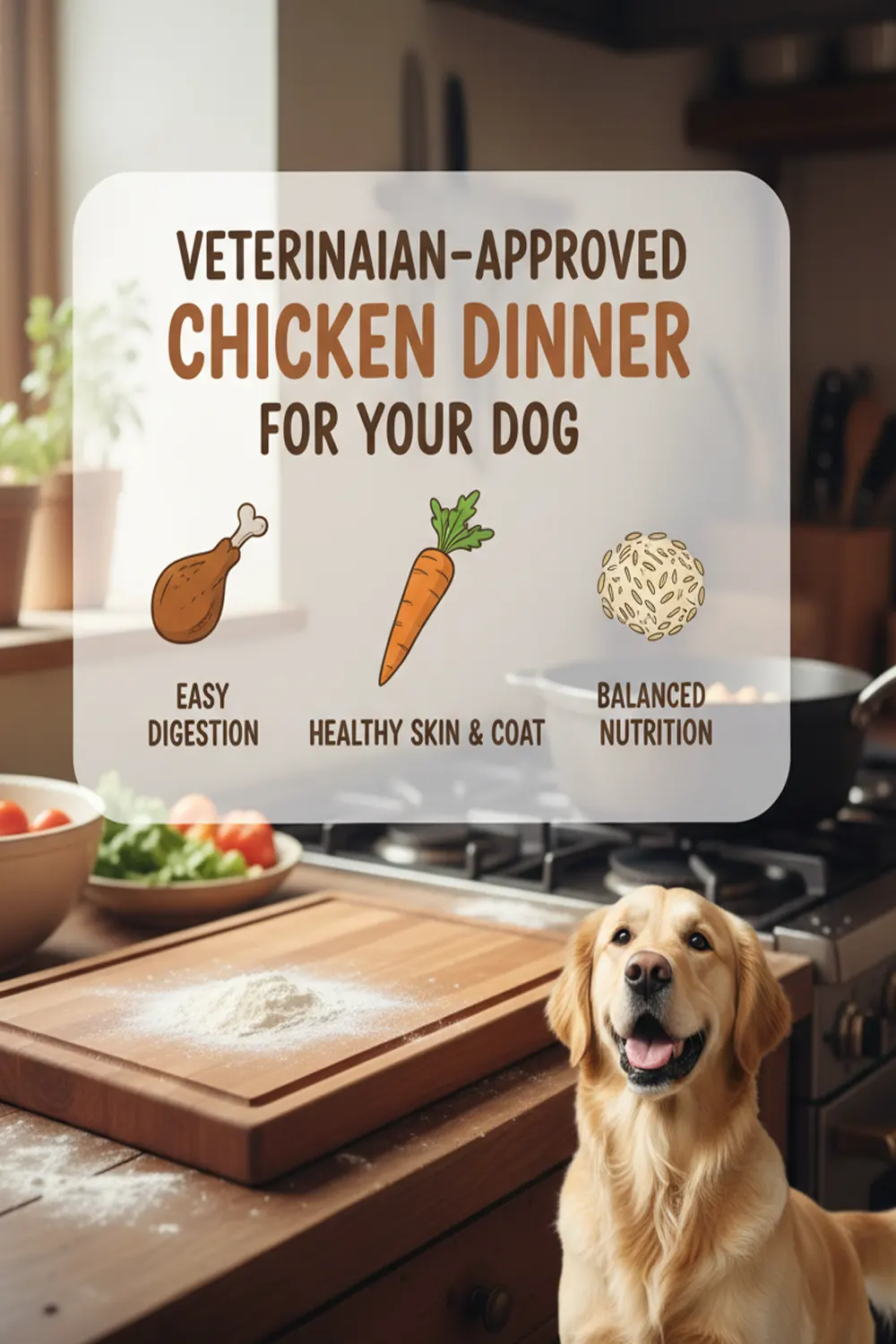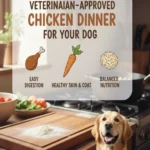Feeding your furry friend a balanced diet is crucial for their health and happiness. If you’re considering making homemade chicken dog food, it’s essential to ensure that the recipes are nutritious and vet-approved. Below are some delightful and wholesome recipes that will make your dog’s tail wag with joy while also meeting their dietary needs.
Why Choose Homemade Chicken Dog Food?
Making homemade dog food allows you to control the ingredients and ensure your dog isn’t ingesting harmful additives. Many veterinarians recommend homemade diets as they can contribute to better overall health. You can customize the recipes to fit your dog’s specific needs, whether they have allergies or prefer certain flavors.
Vet-Approved Chicken Dog Food Recipes
1. Chicken and Brown Rice Recipe
This easy-to-make recipe is a favorite among dogs because of its savory chicken flavor and healthy carbohydrates.
- Ingredients:
- 2 cups brown rice
- 1 tablespoon olive oil
- 3 pounds ground chicken
- 2 cups chopped carrots
- 1 cup peas, frozen or fresh
- 4 cups chicken broth (low sodium)
- Instructions:
- Heat olive oil in a large pot over medium heat.
- Add ground chicken and cook until browned.
- Stir in carrots and peas, cooking for an additional 5 minutes.
- Add brown rice and chicken broth, bringing it to a boil.
- Reduce heat to low and simmer covered for 20 minutes.
- Let cool before serving.
2. Chicken and Vegetable Stew
This hearty stew is not only tasty but packed with vitamins for your pet!
- Ingredients:
- 1 pound chicken thighs (boneless, skinless)
- 4 cups water
- 2 carrots, chopped
- 1 cup green beans, chopped
- 1/2 cup peas
- 1/2 cup pumpkin puree (unsweetened)
- Instructions:
- In a large pot, combine chicken and water; bring to a boil.
- Reduce heat and add carrots, green beans, and peas.
- Simmer for 30 minutes or until chicken is cooked through.
- Remove chicken, shred it, and mix it back into the pot along with pumpkin puree.
- Allow to cool before serving.
3. Chicken, Quinoa, and Spinach Bowl
This nutritious bowl is filled with protein and iron, perfect for active dogs!
- Ingredients:
- 1 cup quinoa
- 2 cups water
- 2 cups cooked chicken, shredded
- 2 cups spinach, wilted
- 1 tablespoon olive oil
- Instructions:
- Rinse quinoa under cold water and combine with water in a pot.
- Bring to a boil, then reduce heat and simmer for 15 minutes.
- In a mixing bowl, combine quinoa, shredded chicken, wilted spinach, and olive oil.
- Serve warm to your furry friend.
Tips for Making Dog Food at Home
When preparing homemade chicken dog food, keep these tips in mind:
- Consult your veterinarian to ensure the recipes meet your dog’s specific dietary needs.
- Introduce new foods gradually to avoid upsetting your dog’s stomach.
- Store leftover food in an airtight container in the refrigerator for up to three days.
Where to Find More Information
For additional guidance and insights into homemade dog foods, consider checking reputable sources such as:
With these delicious homemade chicken dog food recipes, you can ensure your pet enjoys nutritious meals that are vet-approved and filled with love. Happy cooking!
Nutritional Benefits of Homemade Dog Food for Your Canine Companion
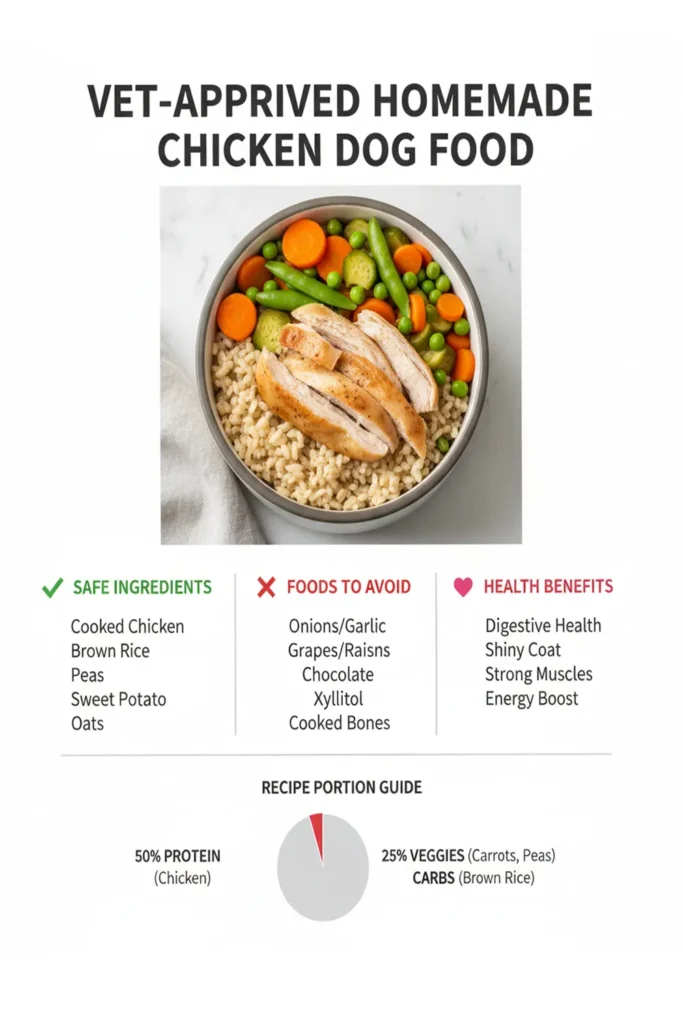
Providing homemade dog food offers numerous nutritional benefits for your canine companion. You can create meals that meet your dog’s specific dietary needs, ensuring they get the best possible nutrition from their food.
High-Quality Ingredients
When you prepare food at home, you have complete control over the ingredients. Commercial dog food often contains fillers and by-products that may not be nutritious. By choosing fresh, whole ingredients, you can provide a diet rich in essential nutrients.
Improved Digestibility
Homemade dog food can also be easier for dogs to digest. Processed foods may contain additives that upset your pet’s stomach. By preparing food at home, you can select ingredients that are gentle on their digestive system.
Customized Nutrition
Every dog has unique nutritional needs based on their age, breed, weight, and health condition. Homemade dog food allows you to tailor meals specifically for your dog. This is crucial for:
- Puppies: Require higher protein and nutrient density for growth.
- Adults: Need a balanced diet to maintain health and activity levels.
- Seniors: Benefit from easier-to-digest foods and added supplements for joint health.
Quality Control
One of the most significant advantages of homemade dog food is the ability to control quality. You choose fresh meats, vegetables, grains, and supplements, ensuring that everything is safe and healthy for your dog. Avoiding harmful additives and focusing on quality ingredients means you can support your dog’s overall health.
Potential Health Benefits
Creating dog food at home can help mitigate various health issues. Here are some potential benefits:
- Weight Management: You can control portion sizes and ingredients to help maintain a healthy weight.
- Allergy Management: Homemade meals can help identify and eliminate allergens by using single-source ingredients.
- Healthier Skin and Coat: foods rich in omega fatty acids can promote a shiny coat.
Cooking for Special Dietary Needs
If your dog requires special dietary considerations, homemade food is invaluable. Dogs with conditions like diabetes, kidney disease, or food intolerances can benefit from tailored diets. Work with your veterinarian to create safe, balanced meals that cater to your dog’s specific needs.
Homemade Dog Food Recipes
Here are a few vet-approved homemade dog food recipes you can try:
| Recipe | Ingredients | Instructions |
|---|---|---|
| Chicken and Rice | 2 cups of chicken (cooked), 1 cup of rice, and 1 cup of green beans. | 1. Cook chicken and rice separately. 2. Mix all ingredients together. Serve when cooled. |
| Beef and Vegetable Stew | 1 pound ground beef, 2 carrots, 1 potato, 1 cup peas. | 1. Brown beef. 2. Add chopped vegetables and water, simmer until tender. |
Consult a Veterinarian
While homemade meals have significant benefits, it’s crucial to consult a veterinarian. They can guide you in balancing nutrients and ensuring that your recipes meet your dog’s dietary requirements. For more information on developing suitable homemade dog food, resources like AKC and Dog Food Advisor can offer valuable insights.
Homemade dog food provides a multitude of nutritional advantages, allowing you to optimize your dog’s health through well-planned meals. You will find joy in preparing food that serves your dog’s needs and contributes to their well-being.
Common Ingredients to Include in Vet-Approved Dog Food Recipes
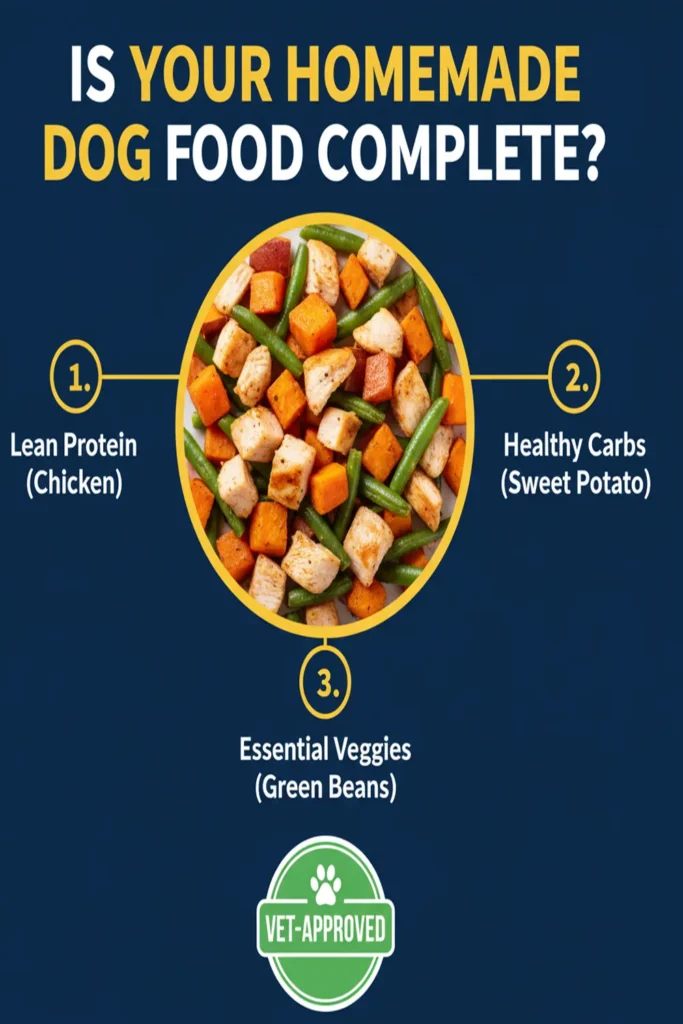
Creating homemade dog food can be a rewarding endeavor, especially when you know it’s made with love and high-quality ingredients. If you want to make sure your furry friend gets the best nutrition, it’s essential to know which ingredients are safe and vet-approved for your homemade dog food recipes. Here are some common ingredients that can lay the groundwork for nutritious and healthy meals for your canine companion.
Proteins
Proteins are vital for your dog’s health. They help with muscle development and overall growth. Here are some proteins that are often recommended:
- Chicken: Lean and easily digestible, chicken is one of the most popular choices among pet owners.
- Turkey: This is another excellent source of protein that provides great flavor and nutrition.
- Beef: Ground beef can be used in moderation and is also a great protein source. Always choose lean cuts and remove any excess fat.
- Fish: Salmon and sardines are nutritious options packed with omega-3 fatty acids, which are beneficial for your dog’s coat and skin.
Vegetables
Vegetables into your dog’s meal can promote health and provide essential vitamins and minerals. Here are some vet-approved vegetables:
- Carrots: Crunchy and sweet, carrots are low in calories and are excellent for your dog’s teeth.
- Green Beans: An excellent source of fiber, green beans can help support digestive health.
- Peas: These are loaded with vitamins and are an excellent source of protein as well.
- Spinach: This leafy green is rich in iron and calcium, but should be included in moderation due to oxalates.
Carbohydrates
Carbohydrates provide the energy that your pet needs. Here are some great options:
- Brown Rice: A good source of carbohydrates, brown rice is easily digestible and soothing for the digestive system.
- Sweet Potatoes: Packed with vitamins A and C, sweet potatoes are a delicious option.
- Oats: They can be a great addition for fiber and are gluten-free.
Fats
Healthy fats are necessary for maintaining healthy skin and coat. Some vet-approved sources of fats include:
- Fish Oil: Rich in omega-3 fatty acids, fish oil can improve your dog’s skin and coat health.
- Flaxseed Oil: Another excellent source of omega-3s, flaxseed oil is beneficial for heart health.
- Chicken Fat: This provides a great source of energy and flavor.
Supplements
Sometimes, homemade diets might lack certain nutrients. Here are a few responsible supplements you might want to consider:
- Calcium: Dogs need calcium for strong bones. You can incorporate ground eggshells in moderation as a natural source.
- Multivitamins: Consulting with your vet about a suitable multivitamin can support overall health.
Ingredients to Avoid
While knowing what to include is essential, it’s equally crucial to know what to avoid:
- Chocolate
- Onions & Garlic
- Grapes & Raisins
- Xylitol (sugar substitute)
Before introducing any new food or ingredient to your dog’s diet, always consult with your veterinarian to ensure it’s the right choice for your specific dog’s needs. For more detailed recipes and vet-approved options, you can refer to [American Kennel Club](https://www.akc.org/expert-advice/lifestyle/homemade-dog-food/) or [The Pet Food Institute](https://www.petfoodinstitute.org/).
Understanding the common ingredients to include in your homemade dog food recipes can significantly enhance your pet’s overall health and happiness. Quality nutrition is key, and making these dishes yourself allows you to control the ingredients your dog consumes, leading to a longer, happier life together.
How to Transition Your Dog to Homemade Meals Safely

Transitioning your dog to homemade meals can be a rewarding endeavor, both for you and for your beloved pet. However, doing it safely requires some planning and mindfulness. Here’s a step-by-step guide to make the process smooth and effective.
Understanding Your Dog’s Nutritional Needs
Before you start preparing homemade meals, it’s essential to understand what nutrients your dog needs. Generally, a balanced dog diet should include:
- Proteins: Essential for growth and muscle health. Chicken, turkey, and beef are great choices.
- Carbohydrates: Provide energy. Brown rice, oats, and sweet potatoes can be included.
- Fats: Necessary for coat and skin health. Fish oil and chicken fat are beneficial.
- Vitamins and Minerals: A variety of fruits and veggies like carrots and blueberries will supply these nutrients.
Consulting Your Veterinarian
Before making any dietary changes, it’s vital to consult with a vet. They can give you personalized advice based on your dog’s age, weight, breed, and health concerns. Many veterinarians can help you formulate a balanced dog food recipe that meets your pet’s specific needs. This is crucial to ensure that your dog receives all the necessary nutrients.
Choosing the Right Time for Transition
The transition to homemade dog food should ideally start during a calm period. Avoid changing your dog’s diet during stressful times, such as moving homes, traveling, or health issues. A stable environment can help your dog adapt to new meals.
Gradual Transition Process
Switching your dog’s diet too quickly can lead to digestive issues like diarrhea or vomiting. To avoid this, follow these steps for a gradual transition:
- Start Slowly: Begin by mixing a small portion of homemade food with your dog’s regular kibble. Start with around 25% homemade food and 75% kibble.
- Monitor Your Dog: For a few days, watch for any signs of discomfort or digestive upset.
- Increase the Ratio: If your dog is tolerating the new mix well, gradually increase the amount of homemade food. Move to a 50/50 mix after a few days.
- Full Transition: After your dog has adapted to the 50/50 mix without any issues, you can transition to 100% homemade food. This might take a week or two, depending on how your dog reacts.
Simple Homemade Chicken Dog Food Recipe
Here’s a vet-approved recipe to kick-start your homemade dog food journey:
| Ingredient | Quantity |
|---|---|
| Ground Chicken | 2 ½ lbs |
| Brown Rice | 1 cup |
| Carrots, diced | ½ cup |
| Peas, canned or frozen | ½ cup |
| Spinach, chopped | ½ cup |
| Fish Oil | 1 tbsp |
| Vitamin and Mineral Supplement | As directed |
In a large saucepan, cook the ground chicken over medium heat until it’s browned. Then, add the brown rice and water, and bring it to a boil. Reduce heat, cover, and let simmer for about 20 minutes. Stir in the carrots, peas, and spinach, and cook for another 5-10 minutes. add the fish oil and any supplements your vet recommends.
Storing Homemade Dog Food
Once you’ve prepared the meals, you’ll want to store them properly. Homemade food can typically be kept in the refrigerator for up to 4 days. You can also freeze portions for later use. Make sure to divide the food into serving sizes and store them in airtight containers.
Monitoring Your Dog’s Health
As you transition to homemade meals, keep an eye on your dog’s health. Look for changes in energy levels, coat quality, and overall well-being. Adjust portions and ingredients based on their needs and any recommendations from your veterinarian.
Homemade chicken dog food into your pet’s diet can enhance their health and happiness. With a careful transition and some thoughtful planning, you’ll ensure that your furry friend enjoys nutritious and satisfying meals. For more information on homemade dog food recipes that are vet-approved, you can visit PetMD or check out the American Kennel Club. Happy cooking!
Understanding Your Dog’s Dietary Needs and Preferences
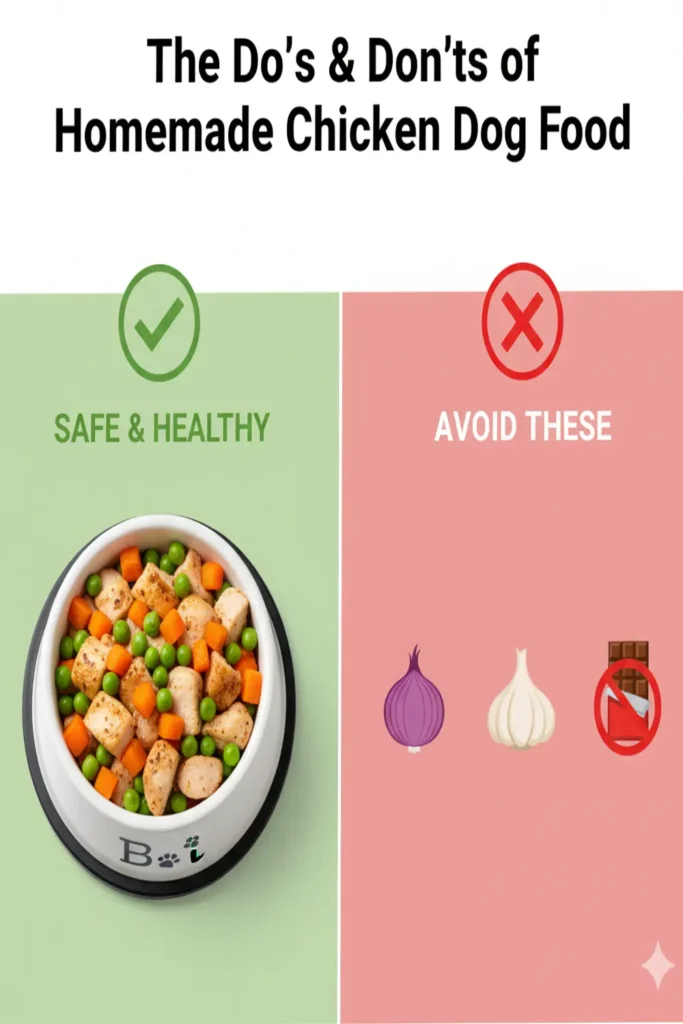
Understanding what your dog needs in terms of diet is essential for their overall health and happiness. Just like humans, dogs benefit from balanced nutrition tailored to their specific requirements. To keep your furry friend healthy, you must pay attention to their dietary needs and preferences.
What Nutrients Do Dogs Need?
The nutritional needs of dogs can vary based on factors like age, size, breed, and activity level. Here’s a list of the essential nutrients your dog needs:
- Protein: Essential for muscle development and repair. Sources include meat, fish, and eggs.
- Carbohydrates: Provide energy. Good sources are whole grains, vegetables, and fruits.
- Fats: Important for a shiny coat and healthy skin, as well as energy. Healthy sources include fish oil and chicken fat.
- Vitamins: Necessary for various bodily functions. They can be found in fruit, vegetables, and supplements.
- Minerals: Required for bone health and metabolic functions. Look for sources like leafy greens and meat.
Understanding Your Dog’s Age and Activity Level
Your dog’s dietary needs can change based on their life stage. Puppies require a higher protein diet for growth, while older dogs may need fewer calories to prevent weight gain. Active dogs often need more calories and protein compared to couch-potato pets. Here’s a general guideline for feeding:
| Dog Age | Dietary Needs |
|---|---|
| Puppy (8 weeks – 1 year) | High protein and fat for growth |
| Adult (1 – 7 years) | Balanced diet for maintenance |
| Senior (7+ years) | Lower calorie, higher fiber, joint support |
Recognizing Your Dog’s Preferences
Dogs can be quite particular about their food. Observing your dog’s preferences can help you make better dietary choices. Some dogs may prefer dry kibble, while others may enjoy wet food or even homemade meals. Here are some tips for understanding your dog’s preferences:
- Observe what your dog enjoys eating; keep an eye on their reactions to different foods.
- Experiment with mixing wet and dry food to find a palatable mix.
- Consider the texture; some dogs may prefer crunchy kibble while others go for something softer.
Consult your Veterinarian
Before making any changes to your dog’s diet, it’s vital to consult your veterinarian. They can provide personalized recommendations based on your dog’s health, breed, and lifestyle. Regular check-ups help ensure your dog is getting the right nutrition at every life stage. For more guidance, check out American Kennel Club Nutrition.
Common Dietary Issues to Be Aware Of
As a dog owner, it’s important to keep an eye out for dietary-related issues. Some common problems include:
- Obesity: Often caused by overfeeding and lack of exercise.
- Food Allergies: Some dogs may react negatively to specific ingredients like grains or proteins.
- Digestive Issues: Changes in diet without a gradual transition can upset your dog’s stomach.
Monitoring your dog’s health and diet can prevent these issues. Regularly assess their weight and look out for any changes in behavior or appetite.
Homemade Dog Food: A Growing Trend
Many pet owners are moving towards homemade meals to better control what goes into their dog’s diet. If you’re interested in trying homemade dog food, ensure that it meets the necessary nutritional standards. Consulting your vet can help you create balanced homemade recipes. Check out some resources at AKC’s guide on homemade dog food.
Understanding your dog’s dietary needs improves their quality of life. By knowing what nutrients are critical, how their age and activity level affect their diet, and recognizing their preferences, you can make informed choices that keep your furry friend healthy and happy.
Conclusion
Creating homemade chicken dog food recipes that are vet-approved can be a rewarding way to show love to your furry friend while ensuring they receive proper nutrition. By including high-quality ingredients, you can meet your dog’s specific dietary needs, providing them with balanced meals that promote overall health. Not only will homemade dog food enhance your pet’s physical well-being, but it can also leave them feeling more energetic and satisfied.
As you craft your recipes, keep in mind some common ingredients that are beneficial for dogs, such as lean chicken, wholesome vegetables, and healthy grains. These components contribute essential nutrients necessary for your dog’s growth and longevity. Vet-approved recipes have been designed with your dog’s health in mind, ensuring they get the right balance of proteins, fats, and carbohydrates.
Transitioning your dog to homemade meals should be done carefully, allowing their digestive system to adjust smoothly. Mixing their current food with new meals gradually can help prevent any stomach issues while ensuring they’re receptive to their new diet. You should always observe how your dog reacts to these changes and adjust their meals based on their preferences and health considerations.
By understanding your dog’s unique dietary needs and tastes, you can customize their meals, making mealtime a joyous experience. The love and effort you put into preparing homemade chicken dog food will deepen your bond with your pet, promote their health, and ultimately create happier days together. Embracing this journey not only benefits your canine companion but can also give you peace of mind, knowing you are providing the best nutrition for their wellbeing.

